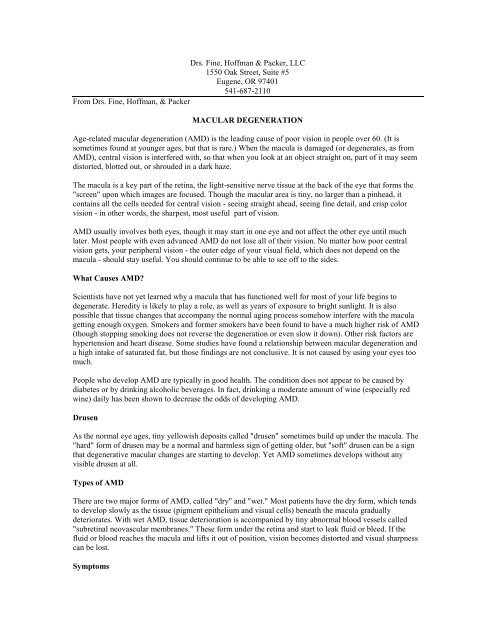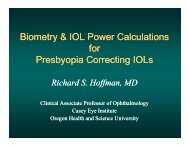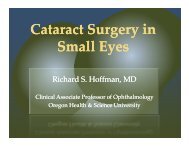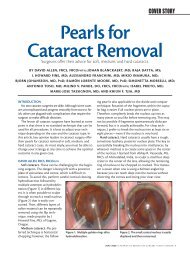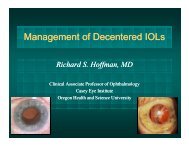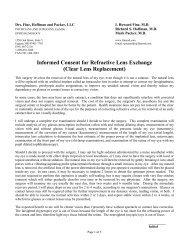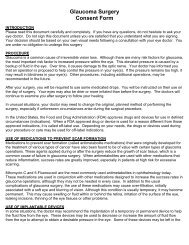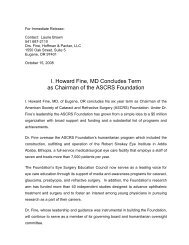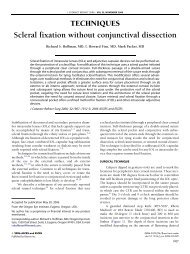Macular Degeneration - Drs. Fine, Hoffman and Packer
Macular Degeneration - Drs. Fine, Hoffman and Packer
Macular Degeneration - Drs. Fine, Hoffman and Packer
You also want an ePaper? Increase the reach of your titles
YUMPU automatically turns print PDFs into web optimized ePapers that Google loves.
<strong>Drs</strong>. <strong>Fine</strong>, <strong>Hoffman</strong> & <strong>Packer</strong>, LLC<br />
1550 Oak Street, Suite #5<br />
Eugene, OR 97401<br />
541-687-2110<br />
From <strong>Drs</strong>. <strong>Fine</strong>, <strong>Hoffman</strong>, & <strong>Packer</strong><br />
MACULAR DEGENERATION<br />
Age-related macular degeneration (AMD) is the leading cause of poor vision in people over 60. (It is<br />
sometimes found at younger ages, but that is rare.) When the macula is damaged (or degenerates, as from<br />
AMD), central vision is interfered with, so that when you look at an object straight on, part of it may seem<br />
distorted, blotted out, or shrouded in a dark haze.<br />
The macula is a key part of the retina, the light-sensitive nerve tissue at the back of the eye that forms the<br />
"screen" upon which images are focused. Though the macular area is tiny, no larger than a pinhead, it<br />
contains all the cells needed for central vision - seeing straight ahead, seeing fine detail, <strong>and</strong> crisp color<br />
vision - in other words, the sharpest, most useful part of vision.<br />
AMD usually involves both eyes, though it may start in one eye <strong>and</strong> not affect the other eye until much<br />
later. Most people with even advanced AMD do not lose all of their vision. No matter how poor central<br />
vision gets, your peripheral vision - the outer edge of your visual field, which does not depend on the<br />
macula - should stay useful. You should continue to be able to see off to the sides.<br />
What Causes AMD?<br />
Scientists have not yet learned why a macula that has functioned well for most of your life begins to<br />
degenerate. Heredity is likely to play a role, as well as years of exposure to bright sunlight. It is also<br />
possible that tissue changes that accompany the normal aging process somehow interfere with the macula<br />
getting enough oxygen. Smokers <strong>and</strong> former smokers have been found to have a much higher risk of AMD<br />
(though stopping smoking does not reverse the degeneration or even slow it down). Other risk factors are<br />
hypertension <strong>and</strong> heart disease. Some studies have found a relationship between macular degeneration <strong>and</strong><br />
a high intake of saturated fat, but those findings are not conclusive. It is not caused by using your eyes too<br />
much.<br />
People who develop AMD are typically in good health. The condition does not appear to be caused by<br />
diabetes or by drinking alcoholic beverages. In fact, drinking a moderate amount of wine (especially red<br />
wine) daily has been shown to decrease the odds of developing AMD.<br />
Drusen<br />
As the normal eye ages, tiny yellowish deposits called "drusen" sometimes build up under the macula. The<br />
"hard" form of drusen may be a normal <strong>and</strong> harmless sign of getting older, but "soft" drusen can be a sign<br />
that degenerative macular changes are starting to develop. Yet AMD sometimes develops without any<br />
visible drusen at all.<br />
Types of AMD<br />
There are two major forms of AMD, called "dry" <strong>and</strong> "wet." Most patients have the dry form, which tends<br />
to develop slowly as the tissue (pigment epithelium <strong>and</strong> visual cells) beneath the macula gradually<br />
deteriorates. With wet AMD, tissue deterioration is accompanied by tiny abnormal blood vessels called<br />
"subretinal neovascular membranes." These form under the retina <strong>and</strong> start to leak fluid or bleed. If the<br />
fluid or blood reaches the macula <strong>and</strong> lifts it out of position, vision becomes distorted <strong>and</strong> visual sharpness<br />
can be lost.<br />
Symptoms
The typical first symptom (in either form) is blurring of vision. When the blurring is gradual, you may<br />
think you need new eyeglasses. But a new prescription is not likely to improve your vision because the<br />
problem is not with the optical parts of the eye.<br />
As time goes on, you may notice a hazy or dark zone in the center of objects you look at directly. Colors<br />
may begin to look different or lose richness. With wet AMD especially, straight lines, such as the edges of<br />
doorways, may start to look bent or crooked as vision becomes distorted <strong>and</strong> wavy. Symptoms may may<br />
be gradual or sudden (suddenness is more likely with wet AMD). When the loss of vision is in one eye<br />
only, you can't always tell how long it has existed, since it is "hidden" when both eyes are used together. It<br />
may only become apparent when the good eye is covered.<br />
Some people whose vision has been very poor (from AMD or from other causes) sometimes have visual<br />
hallucinations; they see things (objects or patterns) that are not really there. These phantom visions can last<br />
from a few seconds to a minute or so <strong>and</strong> then disappear. Such hallucinations are fairly common <strong>and</strong> they<br />
are not serious, but they are startling. Even so, people who have them generally don’t talk about them<br />
freely.<br />
Examination<br />
Your vision will be checked <strong>and</strong> you will have a refraction (test for glasses) along with a complete eye<br />
exam. Your pupils will be dilated (enlarged) with eyedrops so that the insides of your eyes can be evaluated<br />
with an ophthalmoscope. A special type of contact lens may be used for examining both retinas <strong>and</strong><br />
maculas under the high magnification of a slit lamp microscope.<br />
Photographs may be taken of the retina, to determine the extent of the problem <strong>and</strong> evaluate its progression.<br />
You may also have a retinal "angiogram," retinal photographs that help identify the position <strong>and</strong> extent of<br />
any abnormal blood vessels or leakages. For this test, called fluorescein angiography (FA), an orangecolored<br />
dye (fluorescein) is injected into a vein in your arm <strong>and</strong> then a series of photographs is taken as the<br />
dye travels through the eye's blood vessels. If more information is needed, a dye called indocyanine green<br />
(ICG) may be used to make another type of angiogram. Angiograms provide important guidance for<br />
treatment.<br />
Treatment<br />
So far, there are no medications that have proven to be effective. But wet AMD - in the early stages only -<br />
can sometimes benefit from treatment with a surgical laser, to seal the leaks or destroy the abnormal blood<br />
vessels under the macula. (The laser cannot help the dry type of AMD, or even most stages of the wet<br />
type.) The goal of laser treatment is to prevent further leadage <strong>and</strong> stabilize vision. Only occasionally does<br />
vision improve. Please don't expect miracles; the laser treatment may not help at all <strong>and</strong> vision may even<br />
get worse.<br />
Laser surgery is never undertaken lightly. No matter how accurately performed, it involves some risk to<br />
vision because the laser can destroy normal neighboring tissue along with abnormal tissue. So the<br />
procedure will be recommended only if the risk to your vision is small <strong>and</strong> there is a reasonable chance for<br />
success - that means that the degeneration is not too extensive, too advanced, or too near the center of the<br />
macula.<br />
Research<br />
Major clinical research is ongoing at many centers. New treatment <strong>and</strong> prevention methods are constantly<br />
being sought. Certain antioxidants, vitamins, <strong>and</strong> minerals are being studied as a way to slow the<br />
degeneration. Scientific evidence for their effectiveness is still inconclusive; some studies show beneficial<br />
results, others don't. (Until there are answers, you may decide to take a regular vitamin-mineral supplement<br />
for whatever help it might offer.) Several national studies are evaluating the effect of radiation therapy,<br />
especially low-dose X-rays to the eye, to treat the abnormal subretinal blood vessels. Other studies are
aimed at underst<strong>and</strong>ing <strong>and</strong> controlling angiogenesis - the process by which new blood vessel membranes<br />
form under the retina in wet AMD. The results are not in yet.<br />
Several new surgical treatments are under investigation: pigment epithelial transplants, the use of laser<br />
burns to "treat" soft macular drusen, subretinal surgery to remove neovascular membranes, <strong>and</strong> macular<br />
translocation (surgically moving the macula to one side). Another new treatment is called photodynamic<br />
therapy (PDT), in which a light sensitive dye, verteporphin (Visudyne) is injected into the arm. It travels to<br />
the retina, where it concentrates in the abnormal blood vessels under the macula; then a low intensity red<br />
laser is used to destroy these vessels with less damage to the normal cells in the area. This treatment is<br />
usually repeated 3 to 5 times over a year or more, <strong>and</strong> has been shown to be modestly effective in several<br />
national studies. All of these potentially useful treatments must be viewed as experimental at this time.<br />
What To Expect<br />
AMD usually develops gradually or in small spurts over many months, then slows down or stops. Both<br />
eyes will probably be affected, though one eye may precede the other by a long time, even years. Wet<br />
changes occur unpredictably; they may even develop in AMD that started as the dry type, or they may recur<br />
in previously treated wet AMD. It is possible, even with no laser treatment, for the degenerative process to<br />
stop before very much vision has been lost. But it is more likely that central vision will continue<br />
decreasing, probably to the point that reading is hampered <strong>and</strong> driving a car is no longer safe.<br />
If vision in both eyes drops to a level that eyeglasses cannot improve to better than 20/200 (the "big E" on<br />
the eye chart), the term "legal blindness" is used. But don't let that frighten you. This is merely a legal<br />
definition used to determine eligibility for certain social services (<strong>and</strong> an extra income tax exemption).<br />
Remember, even if the degeneration is severe, side vision will remain normal. You should continue to see<br />
well enough to move about comfortably <strong>and</strong> care for yourself. Some patients even surprise everyone by<br />
being able to see <strong>and</strong> pick up small objects from the floor.<br />
What You Can Do<br />
In addition to having regular eye exams, there is an easy <strong>and</strong> important test you can do yourself. Take a few<br />
seconds every day to check your vision with an Amsler grid, a card printed with a pattern of crossing lines<br />
that form small squares. Test each eye separately, with the other eye covered. The lines should look straight<br />
<strong>and</strong> solid. If any lines suddenly start looking wavy or having missing segments, that could indicate the<br />
beginning of wet changes that might be treatable, <strong>and</strong> you should make an appointment right away, to have<br />
your eyes examined within the next few days.<br />
It is frightening to face the prospect of losing central vision. But there are ways to use your remaining sight<br />
to best advantage. Most people quickly learn how to use their peripheral vision more effectively, such as by<br />
learning to look slightly off-center. A low vision specialist can be a great help. This professional can work<br />
with you to select magnification devices for seeing better in specific situations. He or she will also<br />
introduce you to non-optical aids, such as large-type books <strong>and</strong> magazines, large press-on numbers for your<br />
appliances, <strong>and</strong> even talking clocks.<br />
Consider joining a support group. You may find it comforting to talk to others who share similar problems<br />
<strong>and</strong> exchange ideas with them. If your problem seems especially overwhelming, you may wish to seek<br />
professional psychological support.<br />
Always keep in mind that using your eyes will never harm them. You can continue any of your usual<br />
activities as long as you feel comfortable doing them. Even with reduced vision, your life can be<br />
surprisingly normal <strong>and</strong> fulfilling.<br />
For up-to-date, reliable information, two nonprofit organizations invite you to contact them: Research to<br />
Prevent Blindness (645 Madison Ave., 21st floor, New York, NY 10022; 1-800-621-0026; fax 212-688-<br />
6231; e-mail info@rpbusa.org) can provide the latest research results, <strong>and</strong> The Foundation Fighting
Blindness, offers information, a newsletter, <strong>and</strong> location of support groups (Executive Plaza 1, 11350<br />
McCormick Rd., Suite 800, Hunt Valley, MD 21031; 1-800-683-5555; TDD 1-800-683-5551).


